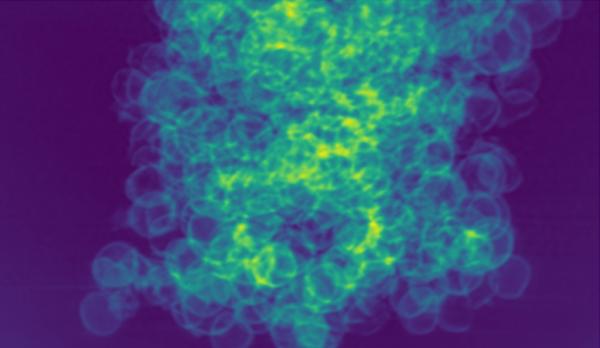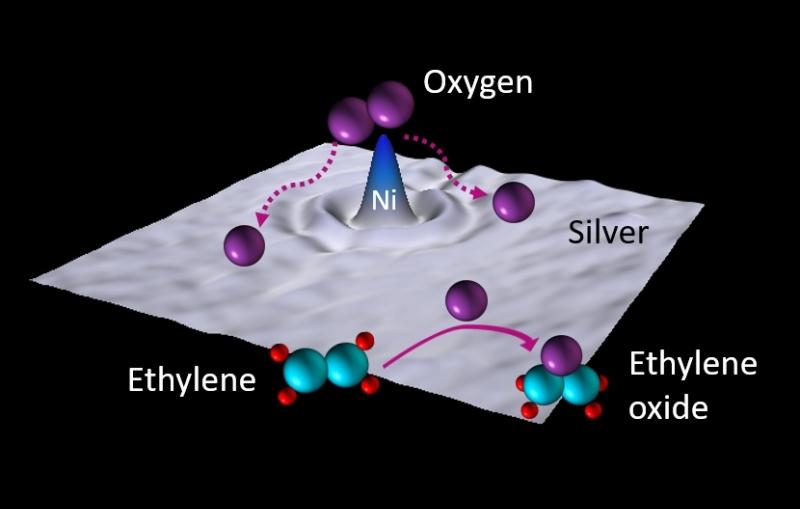What will it take to bring fusion energy to the US power grid?
In this Q&A, Arianna Gleason discusses the technologies needed to make commercialized fusion energy a reality and how SLAC is advancing this energy frontier.
Arianna Gleason is an award-winning scientist at the Department of Energy’s SLAC National Accelerator Laboratory who studies matter in its most extreme forms – from roiling magma in the center of our planet to the conditions inside the heart of distant stars. During Fusion Energy Week, we caught up with Gleason about the current state of fusion energy research and how SLAC is helping push the field forward.
What is fusion energy?
Fusion is at the heart of every star. The tremendous pressure and temperature at the center of a star fuses atoms together, creating many of the elements you see on the periodic table and generating an immense amount of energy. Fusion is exciting, because it could provide unlimited energy to our power grid. We’re trying to replicate fusion energy here on Earth, though it’s a tremendous challenge of science and engineering.
Have we ever been able to replicate fusion in a lab?
What is inertial fusion energy?
SLAC experts explain the science behind IFE, an approach to generating energy using fusion fuel and lasers.

Fusion has been at the forefront of scientific inquiry for many decades, but it wasn’t until December 2022 that we reached an incredible watershed moment in fusion research. Using a technique called inertial fusion energy, or IFE, researchers at Lawrence Livermore National Laboratory’s National Ignition Facility (NIF) focused 192 individual lasers on a fuel “target” – about the size of a pea – made of deuterium and tritium. These lasers applied a tremendous force onto the target, and it imploded into a burning plasma. The deuterium and tritium atoms fused together, generating helium and a neutron and producing more energy from the reaction than was used to create it. For less than a trillionth of a second, researchers created the center of a star on Earth. After more than 50 years of fusion research, the world finally achieved net energy gain.
That’s incredible, but – a trillionth of a second? That seems pretty short.
Very short! The idea is that this process – this burning plasma – can be repeated many times per second, driven by a series of laser shots that create a source of power. Think of it like a car engine: A spark (the laser) ignites the fuel (the fusion fuel target), which only burns for a short time, but repeated cycles of ignition and burning drive sustained power. In the case of inertial fusion energy, this would be the equivalent of a one million horsepower engine.
Right now, the NIF produces one or two shots each day. We’re trying to go from one shot each day to multiple shots each second. If we can orchestrate these implosions multiple times a second, we can generate a continuous flow of power – and do so in a way that is safe, carbon-free and at a scale that meets the long-term energy demands of our world.
Now that we know fusion is possible on Earth, how far are we from having this unlimited energy source on our national power grid?
Arianna Gleason
Staff scientist and deputy director of SLAC's High Energy Density Science division

There are numerous barriers we need to overcome before commercialized fusion energy is a reality. As I said before, we need to move from one laser shot each day to something on the order of 10 shots per second. High repetition rate is critical. Beyond that, we need to develop the technology to deliver the fuel targets into the fusion chamber, track their movements and engage them with lasers at the same rate – 10 times per second. The third challenge is designing the targets themselves to ensure they fuse and generate energy every single time. Right now, our understanding of the physics and materials science of these targets is at an early stage – a very low technology readiness level.
Even more foundationally, we need people. We need to be training up experts at every level – from power plant operators, technicians and electricians to PhDs in science and engineering. These are good jobs that can be domestically sourced. We need to be educating the workforce, at all levels, for power plant design and operation.
What is SLAC doing to address these challenges?
SLAC is furthering fusion energy science and technology in several ways, including in partnership with other national labs, universities and private companies.
One significant opportunity is the challenge of high repetition rates – moving from one laser shot per day to 10 shots every second. SLAC has years of experience on exactly this topic. We are home to the only domestic X-ray free electron laser, the Linac Coherent Light Source (LCLS), and its cutting-edge experimental end stations. We’re leveraging these facilities to build up the capabilities for high-repetition laser-target interactions.

The challenge is getting everything just right and at the right scale for fusion. For each laser-target interaction, the target must be exactly positioned and its movements continuously tracked and predicted with a high degree of accuracy. The optics – the mirrors and lenses – must be precisely adjusted to direct the lasers. Achieving this perfection at a system scale, like that of a power plant, is tremendously difficult, and demands meticulous, step-by-step testing to get all the bugs and kinks worked out.
Because of SLAC’s unique expertise and facilities – for instance, operating high-repetition rate facilities like LCLS which require the synchronization of many systems – we are well-positioned to tackle that complexity. If we want to build a foundational understanding, develop best practices and do mid-scale demonstrations to tune the design for high repetition rates, there really is no better place. We already have all the pieces in the same location here at SLAC.
What about other areas, like target tracking and target material design?
LCLS provides X-ray pulses to advanced end stations, including the Matter in Extreme Conditions (MEC) and Megaelectronvolt Ultrafast Electron Diffraction (MeV-UED) end stations. Both MEC and MeV-UED have their own unique superpowers that help us advance fusion technologies.

At MEC, we combine ultrafast X-ray pulses from LCLS with ultrahigh-power lasers. This allows us to replicate the complexities of targets under extreme conditions, like those of a fusion target chamber, and to test target delivery and tracking systems. We are building up advanced systems and diagnostics, then training people to develop the skills they need to orchestrate repeated, consistent target delivery.
MEC also helps us study materials for fusion fuel targets. For example, one potential fusion fuel target is a porous foam – like the sponge on your kitchen sink – that can absorb liquid fuels, such as deuterium and tritium. When a powerful laser is directed at the foam capsule, the outer layer forms plasma, generating a shockwave that compresses the sample and initiates the fusion process. Cool, right?
With MEC, we can replicate this process and watch the foam's response in real-time, visualizing how the fuel capsule material behaves under these extreme conditions. This data feeds into our computational models and simulations, allowing us to make more accurate predictions about how all these systems might come together in a power plant.
And what is the MeV-UED’s superpower?
We use the MeV-UED facility to study the structural materials needed for building a fusion target chamber. These materials will endure harsh conditions, including radiation and high neutron flux, that can degrade them over time. MeV-UED helps us understand how different materials will behave in those conditions and identify the most durable options.
Looks like some great headway on the technical challenges. But what about building up a workforce?
SLAC is a destination for students who are excited to work in fusion. We have the large-scale facilities onsite, paired with a High Energy Density Science program where students learn from Stanford faculty across disciplines. Beyond that, we’re the headquarters for LaserNetUS, a collaborative network of laser facilities across the U.S. and Canada. This partnership allows students and postdocs to conduct experiments, connect with the commercial sector and learn from experts across the continent. We’re both a home base and a launch pad for careers in fusion energy.

You mentioned that fusion power plants will need a workforce beyond scientists and engineers. How can we build up that workforce across the nation?
I’m co-leading a new initiative called Inertial Fusion Energy 50, or IFE 50. As part of the Department of Energy’s IFE-STAR Ecosystem, IFE 50 aims to make connections with every single state in the U.S. We want to generate a community network across academia, national labs and private industry, laying the groundwork for strong American jobs that offer real value to each state. Is there a local vendor that can supply raw materials? Is there interest in starting a new trade school program that will support the electrical, mechanical and HVAC systems needed at power plants? We want to start having those conversations now, so that when the technology is ready, the American workforce is, too.
Why is this work so important to you?
Fusion energy
Dive deeper into fusion energy research at SLAC

I am so excited to come into SLAC every day. We do such incredible work here, leveraging our unique facilities and our people. And you know, it doesn’t stop at fusion energy – our work translates to many areas of energy and security that help make our country strong and secure. We are so proud of what we do.
Fusion science and technology research at SLAC is funded in part by the Department of Energy’s IFE RISE and STARFIRE Hubs and TINeX FIRE Collaborative. LCLS is a DOE Office of Science user facility.
For questions or comments, contact SLAC Strategic Communications & External Affairs at communications@slac.stanford.edu.
About SLAC
SLAC National Accelerator Laboratory explores how the universe works at the biggest, smallest and fastest scales and invents powerful tools used by researchers around the globe. As world leaders in ultrafast science and bold explorers of the physics of the universe, we forge new ground in understanding our origins and building a healthier and more sustainable future. Our discovery and innovation help develop new materials and chemical processes and open unprecedented views of the cosmos and life’s most delicate machinery. Building on more than 60 years of visionary research, we help shape the future by advancing areas such as quantum technology, scientific computing and the development of next-generation accelerators.
SLAC is operated by Stanford University for the U.S. Department of Energy’s Office of Science. The Office of Science is the single largest supporter of basic research in the physical sciences in the United States and is working to address some of the most pressing challenges of our time.






